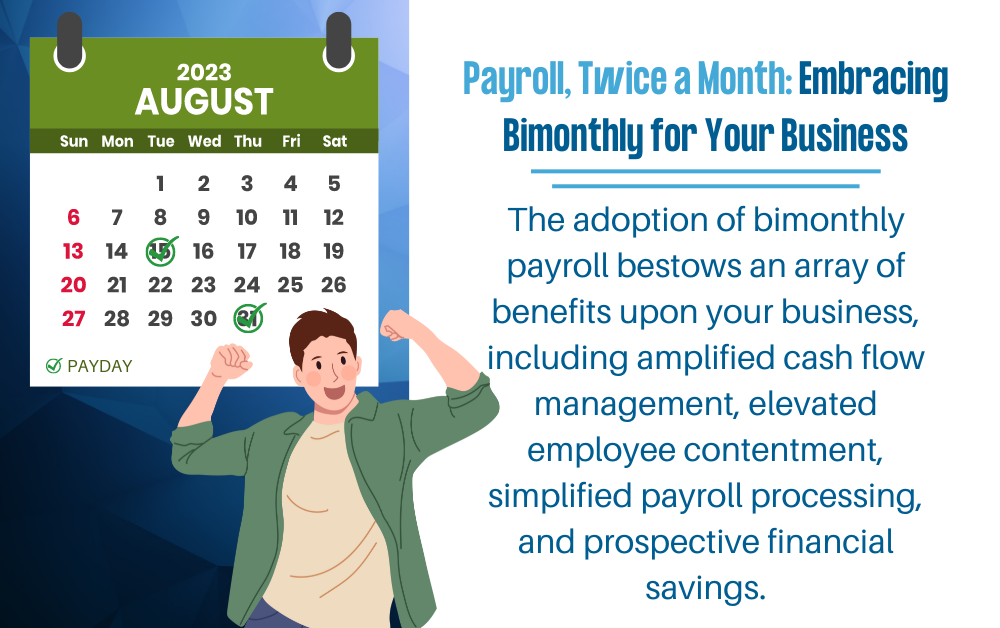Managing a business involves various facets, with payroll management being a crucial component. A well-organized payroll system ensures accurate and prompt compensation for your employees, thereby contributing to their job satisfaction and overall productivity. In the ever-evolving landscape of business operations, finding ways to streamline processes, save time, and enhance efficiency is paramount. One strategy that is gaining traction in the business world is the adoption of bimonthly payroll. In this blog post, we’ll delve into the benefits of embracing bimonthly payroll for your business and examine how it can catalyze positive transformations across your operations.
Decoding Bimonthly Payroll
Bimonthly payroll involves processing payroll for your workforce twice a month, making it a compensation methodology with distinct characteristics. Unlike the conventional monthly or weekly payroll systems, which result in either one or four payment cycles per month, bimonthly payroll strikes a balance. The two payment periods usually occur at regular intervals within the month – typically around the 15th and the last day of the month. This consistent rhythm offers several advantages for both employers and employees alike.
Augmented Cash Flow Management
One of the primary benefits of implementing bimonthly payroll is the notable enhancement in cash flow management. The staggered payment schedule affords you the opportunity to forecast payroll expenses more accurately, allowing you to allocate funds judiciously. This, in turn, prevents financial strain towards the end of the month when a majority of bills are due. The ability to anticipate financial needs empowers you to formulate more informed budgets and comprehensive plans.
Fostering Employee Financial Stability
Bimonthly paychecks, characterized by their consistent frequency, are widely appreciated by employees. This predictability facilitates better management of personal finances, spanning from essential bills to rent and other expenditures. Such stability contributes to reducing financial stress among your workforce, nurturing an environment of contentment and a sense of security.
Streamlined Payroll Processing
From an employer’s perspective, bimonthly payroll can significantly simplify the intricacies of payroll processing. With just two pay runs each month, the administrative burden diminishes compared to more frequent payroll cycles. This reduced workload frees up you and your HR team to allocate resources to other vital business aspects.
The Promise of Potential Cost Savings
The transition to bimonthly payroll has the potential to yield cost savings. Payroll processing comes with associated expenses, encompassing labor, software, and administrative overheads. By shifting to a bimonthly model, opportunities for optimizing the payroll process arise, possibly leading to long-term financial savings for your business.
A Strategic Leap Towards Business Growth
The adoption of bimonthly payroll also serves as a strategic maneuver for fostering business growth. The time and resources saved through streamlined payroll processing can be reallocated towards expanding operations, enhancing customer service, or embarking on innovative marketing ventures. With a leaner and more efficient payroll system, you can concentrate on your core competencies – amplifying your business and augmenting your bottom line.
Putting Bimonthly Payroll into Practice
Should you decide to embrace bimonthly payroll, a smooth transition necessitates careful planning and transparent communication with your employees. Here’s a roadmap to consider:
- Educate and Engage: Introduce the upcoming changes to your employees, elucidating how the new bimonthly system will affect their payment schedule. Address queries and concerns promptly.
- Refine Payroll Policies: Review and revise your payroll policies to accommodate the adjusted bimonthly schedule. Provide clear delineation of pay dates, submission deadlines, and any relevant information.
- Internal Adjustments: Ensure your internal systems and processes are primes for the transition. Prepare your accounting and HR teams to adeptly handle the new payroll frequency.
- Transparent Communication: Maintain open channels of communication throughout the transition. Offer reminders about the revised pay schedule and tackle any challenges that arise proactively.
For Efficiency and Growth
In conclusion, the adoption of bimonthly payroll bestows an array of benefits upon your business, including amplified cash flow management, elevated employee contentment, simplified payroll processing, and prospective financial savings. By embracing this strategy, you can allocate more time and resources to your core business undertakings, creating an environment conducive to stability and productivity. If you’re ready to streamline payroll and focus on business expansion, bimonthly payroll integration could be your needed catalyst.
When you’re ready to embark on this transformative journey, keep in mind that expert payroll solutions, tailored to your unique business needs, are waiting for you. Contact BCM Payroll, where our adept team is dedicated to addressing your payroll needs. Let us handle the intricate details while you dedicate your efforts to your passion – expanding your business and realizing your aspirations.

